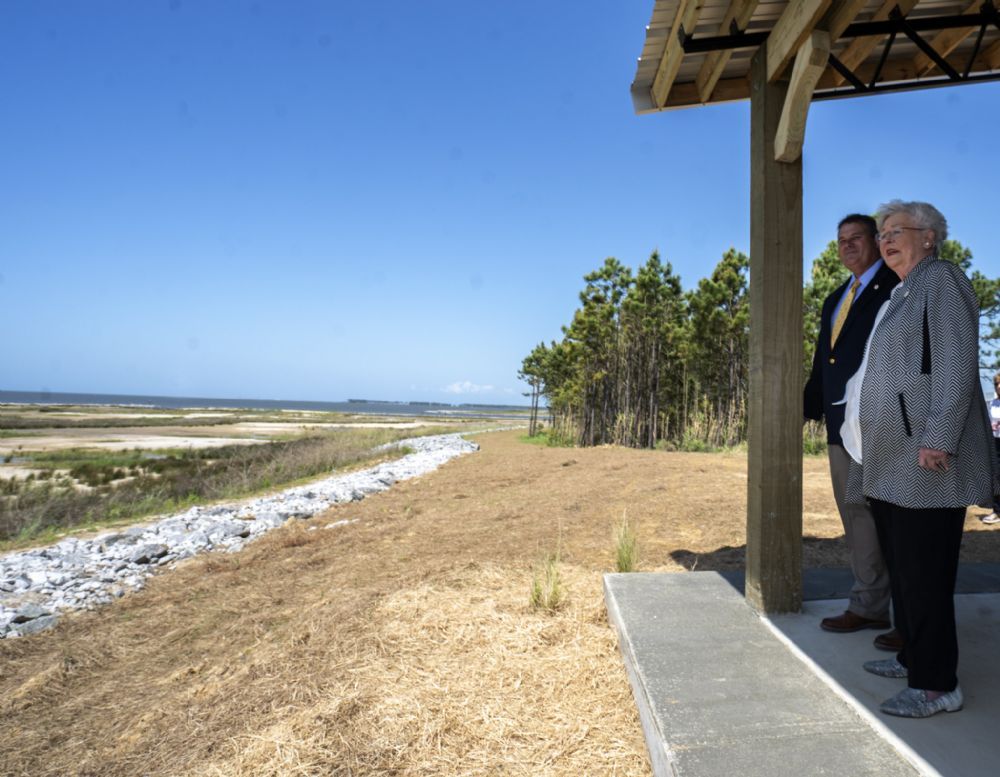Governor Kay Ivey announced on Thursday that The National Fish and Wildlife Foundation (NFWF) recently approved five new projects in Alabama totaling more than $47 million. The projects announced were selected for funding after extensive consultation with the Alabama Department of Conservation and Natural Resources and federal resource agencies.
The projects are:
Dauphin Island East End Restoration—Phase II
$26,066,000
Gulf Highlands Conservation Acquisition—Amendment
$8,200,000
Lower Fish River Watershed Restoration—Phase II
$9,003,000
Wolf and Sandy Creek Headwaters Restoration—Phase II
$2,788,000
Alabama Coastal Adaptive Management
$1,000,000
$47,057,000
These projects are the final funding obligations from the Gulf Environmental Benefit Fund (GEBF) for projects in the state of Alabama, bringing its total awards from the fund to more than $356 million. This announcement caps 10 years of restoration funding undertaken by NFWF to support projects in Alabama following the 2010 Deepwater Horizon tragedy.
“As we celebrate Alabama’s 2022 slate of NFWF projects and announce the final allocation of Alabama’s portion of the Gulf Environmental Benefit Funds, we recognize another landmark in Alabama’s recovery from the Deepwater Horizon Oil Spill disaster,” said Governor Ivey. “The $356 million dollars awarded to Alabama in criminal fines, managed by NFWF, funded some of the first Deepwater Horizon Restoration Projects implemented in Coastal Alabama.
“Together, these investments tell a story of significant accomplishments that will go a long way in protecting Alabama’s diverse, coastal ecosystem for decades to come. Whether it be our investments into maintaining the coastal reefs that support our thriving red snapper fishery or our land conservation efforts to protect game and non-game species in places like the Perdido River Corridor, Fort Morgan Peninsula and the Grand Bay Savanna, there is no doubt Alabama has made the absolute most of these funds.”
“I thank the National Fish and Wildlife Foundation for their partnership and dedication to the restoration and protection of Alabama’s natural resources, and for their capable and dedicated management of the Gulf Environmental Benefit Fund,” added Governor Ivey.
“While this marks the completion of our allocation of the NFWF portion of the BP Settlement, our work continues to restore Coastal Alabama. I would like to recognize Conservation Commissioner Chris Blankenship, DWH Restoration Coordinator Amy Hunter and the team at the Alabama Department of Conservation and Natural Resources for the work they continue to do for the citizens and natural resources of Coastal Alabama.”
Over the past decade, NFWF’s investments have made significant contributions to the long-term sustainability of critical coastal resources in Alabama, including:
Nearly 9,000 acres of important habitats acquired, conserved, restored or enhanced
Nearly 11 miles of vulnerable shoreline protected
Improved water quality through three miles of stream restoration that will avoid 50-70 million pounds of sediment annually
More than 250 acres of artificial reef habitat and thousands of artificial reefs installed to enhance fish productivity
Sustainable fisheries management through comprehensive science and monitoring
Increased capacity and habitat enhancements to bolster populations of coastal birds, marine mammals, and sea turtles
Restoration of more than 800 acres of oyster reef habitat
An interactive story map of Alabama projects supported by GEBF can be found here.
Since its inception, the GEBF has supported 47 natural resource projects in Alabama and worked with 39 implementing partners. These projects leverage or complement nearly $200 million in other funding for a total conservation impact of more than $555 million to benefit natural resources negatively affected by the 2010 oil spill.
“Today’s announcement represents the culmination of historic conservation investments in Alabama following the Deepwater Horizon tragedy,” said Jeff Trandahl, executive director and CEO of NFWF. “Working closely with the Alabama Department of Conservation and Natural Resources, we have made strategic investments that support fish and wildlife and their habitats. These projects will continue to enhance the productivity and resilience of the Alabama coast for decades to come.”
Among the many accomplishments that have been made or are underway, NFWF and its partners have made strategic investments to protect and enhance strategic habitats, improve shoreline resilience, restore watersheds and enhance fisheries habitats and science. Collectively, these investments will have a lasting impact on the Alabama coast for decades to come. Broadly, these investments have included:
Strategic Habitat Protection
GEBF has invested more than $100 million into 12 projects in Alabama to acquire and permanently protect approximately 7,500 acres of important coastal habitat. Through their inclusion within existing publicly owned conservation lands, these lands will offer expanded public access to this impressive suite of properties along the Alabama coast. These properties are now being managed to remove invasive species, restore native flora and improve ecologic function.
Conserving Alabama’s Barrier Island
Dauphin Island is Alabama’s only barrier island and one of the largest on the Gulf Coast, stretching 14 miles. It provides valuable wildlife habitat and protects important Mississippi Sound resources while also maintaining ecological conditions (salinity) within the Sound that are critical to its fisheries, oysters and seagrass beds. The island is also a significant trans-Gulf migratory bird stopover area and provides habitat to numerous beach-nesting birds. Often subject to significant severe weather events, Dauphin Island’s restoration and long-term resilience were the subject of key focal investments under the GEBF. Guided by a GEBF-funded restoration plan, NFWF has awarded nearly $50 million in GEBF funds to nine projects to enhance and protect this vital island.
Enhancing Coastal Resilience through Shoreline Restoration
Annual loss of shoreline habitat on the western shore of Mobile Bay has averaged more than two feet in some areas. Since 2001, more than 11 percent of overall shoreline acreage has been lost due to erosion caused by storms, marine traffic and natural degradation. Investments in shoreline protection and wetland restoration are key to restoring and enhancing the ecological function of these critical habitats, and they also represent a nature-based approach to protecting coastal communities and infrastructure. Nearly $120 million in GEBF funds to support shoreline restoration has also leveraged more than $20 million in NFWF’s Coastal Resilience funding to strengthen Alabama’s natural defenses and improve the ecology of coastal waters.
Watershed Restorations
Degradation of watersheds and coastal streams has coincided with significant growth in the region over the past several decades. GEBF investments in watershed planning by the Mobile Bay National Estuary Program were instrumental in identifying and prioritizing the most cost-effective restoration activities to improve water quality along the coast. Projects that improve water quality by reducing sediment and nutrient loads have significant benefits to marsh habitats, submerged aquatic vegetation, oyster reefs and other marine species.
GEBF funding also enhanced a longstanding partnership with the U.S. Department of Agriculture’s Natural Resource Conservation Service to work with farmers and ranchers in coastal Alabama to implement conservation easements and best management practices worth more than $14.5 million on more than 30,000 acres to enhance water quality and improve habitat.
Bolstering Alabama’s Fisheries
The GEBF has invested over $44 million in Alabama to bolster fish populations through habitat creation and improved monitoring and management. Monitoring of fish populations in Alabama has produced a wealth of data that is informing management of vital commercially and economically important fisheries. This investment also increased scientific capacity that will endure. GEBF investments also created over 1,000 acres of reef habitat in Alabama, including 800 acres of nearshore oyster reef and 250 acres of near- and offshore artificial reef habitat suitable for red snapper and other offshore reef species.
For more information on coastal restoration projects in Alabama from all Deepwater Horizon funding sources, please visit https://www.alabamacoastalrestoration.org.


 Login
Login




